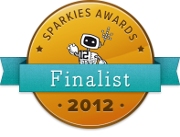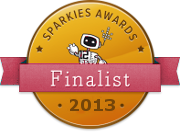Did you fall for the NSPCC Facebook hoax?
Facebook profile images have mysteriously been changing to cartoon characters. Why? Because this message has been passed around:
“Change your Facebook profile picture to a cartoon character from your childhood and invite your friends to do the same, for the NSPCC. Until Monday (December 6th), there should be no human faces on Facebook, but an invasion of memories. This is a campaign to stop violence against children”

Did you think like me that you could help a charity by changing your profile picture? I changed mine to a character from the 1980s cartoon 'Mysterious Cities of Gold'
Sadly, it’s all a hoax! I fell for it, and I found out that it’s been going around for a while. But this got me thinking: Why are we so easily fooled?
And does it matter anyway if we are gullible?
Update! Find out if you just can’t resist following the crowd in this new post: ‘Do you do just follow the crowd?’
Today’s blog looks at some of the best and worst internet hoaxes and tips on how not to get suckered into an internet scam…
My first reaction to the “NSPCC” message was to ignore it. Soon lots of other people were starting to change their facebook profiles to cartoon characters, so I followed suit. Why?
Was it a sense of guilt? Perhaps it was peer pressure or a sense of respect for other people who had changed their profile images…
Do You Conform Easily?
We all have an inbuilt desire to fit in; be it with friends, family or peers. It’s pretty much the same regardless of our culture.
Back in the 1950’s, a researcher called Solomon Asch did some simple experiments to find out how strong the desire to conform really was:
Can you tell that the lines are the same length?
But imagine for a moment that you are surrounded by people who all said that line B was longer? Would you be strong enough to stand out from the crowd?
Solomon Asch tested this by putting subjects in a room of ‘stooges’ who all said line B was longer. The result? Nearly everyone went along with the majority…
So perhaps it is this power of conformity that compels us to go along with the crowd and forces us into decisions against our better judgement.
The NSPCC hoax seems pretty harmless, but how would you fare with these scams?
Internet Hoaxes and Scams
An email after your money:
FROM: Dr Altaka Yurmani
Central Bank of Nigeria
Lagos, Nigeria
01-658-21-2658
TO: CEO
Everytown, USA
Dear Sir:
I have been requested by the Nigerian National Petroleum Company to contact you for assistance in resolving a matter. The Nigerian National Petroleum Company has recently concluded a large number of contracts for oil exploration in the sub-Sahara region. The contracts have immediately produced moneys equaling US$40,000,000.
Most of us get email spam, this one is the classic “Nigerian 419 Letter“! They all end up with asking you for contact details or bank details on the promise of money…
An email chain letter:
These are emails that pursuade you in one way or another to forward it on to your friends. It’s either the promise of money or for some worthwhile cause. They are virtually all fakes. So, if in doubt just hit the delete key…
Here’s a classic one that’s been floating around since 1998 and still exists today:
Dear Friends; Please do not take this for a junk letter. Bill Gates sharing his fortune. If you ignore this, You will repent later. Microsoft and AOL are now the largest Internet companies and in an effort to make sure that Internet Explorer remains the most widely used program, Microsoft and AOL are running an e-mail beta test.
When you forward this e-mail to friends, Microsoft can and will track it ( If you are a Microsoft Windows user) For a two weeks time period.
For every person that you forward this e-mail to, Microsoft will pay you $245.00 For every person that you sent it to that forwards it on, Microsoft will pay you $243.00 and for every third person that receives it, You will be paid $241.00. Within two weeks, Microsoft will contact you for your address and then send you a check.
Virus Hoaxes:
Sometimes emails warn you about a new ‘incurable’ computer virus that you MUST forward to all your friends. Again, a load of nonsense! I quite like this one, which tells you delete a harmless file that should be on any Windows computer:
SORRY - but as you’re on my address list this virus has probably forwarded itself on to you.
It is easily removed if you don’t open the file (jdbgmgr.exe) It has a teddy bear icon and is not detectable by norton or mcafee.
First go to Start then the find or search option. In the files or folders option type jdbgmgr.exe. Search C drive and tick the ‘include subfolders’ and any other drives you may have. Click ‘find now’ - the virus has a grey teddy icon. DO NOT OPEN IT. Go to edit (on the menu bar) and ‘select all’. Now go to file (on the menu bar) and DELETE. This will send it to the recycle bin so then go and delet or empty it there as well.
If you find the virus (as I did!) you must contact everyone in your address book and send them these instructions. ASAP.
The cost of Internet Hoaxes
As long as it’s not trying to trick you into giving money, isn’t it’s all a bit of harmless fun? Well some people have done the maths and if everyone on the internet were sent one hoax message and spend one minute reading it then the global cost in lost time would be $41.7 million (US)!! Astonishing…
Some tips on avoiding hoaxes:
At the risk of sounding patronising, I found these helpful tips on About.com for not falling victim to an internet hoax again:
- Take a time out. If the e-mail sounds like a hoax, it probably is. Do not instantly react to save the world. You can be certain, if it’s a real threat, the news media and legitimate antivirus sources will publish all the necessary alerts.
- Check out the facts. The Hoax Information Center provides a comprehensive list of the most common hoaxes.
- Ask for help. If you are at a company, ask your system administrator or desktop support person to verify its accuracy.
- Do some research. Try a simple search on a site such as Google to see what information there is about it.
- When in doubt, don’t sent it out.
On reflection, the facebook message had some tell-tale signs suggesting it was a fake; A strict time limit to take part, an opportunity to support a good cause for free and a chance to show other people that you care!
Even so, the NSPCC seem to have been quite flattered by all the attention they’ve got. In an official statement on their facebook page they said
“Although the NSPCC did not originate the childhood cartoon Facebook campaign, we welcome the attention it has brought to the work we do”
So perhaps it’s done a good job after all?!
Read more:
Think it might be a hoax? Check it out at the Hoax Information Center
Find out more about Email Chain letters at: http://www.breakthechain.org/
Learn about Conformity experiments here
Find out more about the NSPCC here












FACEBOOK CARTOON FAD= FAKE campaign
Paedophile Rumour= FAKE call
NSPCC= FAKE charity
* If a charity pays it’s executives hundreds of thousands or millions of pounds a year, it probably doesnt need your money!
* If the charity gets huge amounts of money from the government, it probably doesn’t need your money!
* If the charity can afford to spend large proportions of it’s income on advertising campaigns, it probably doesn’t need your money!
FULL STOP!
Posted by HolisticHumanist | December 6, 2010, 10:56 pm